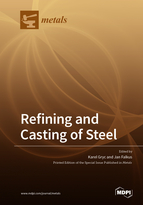Refining and Casting of Steel
A special issue of Metals (ISSN 2075-4701).
Deadline for manuscript submissions: closed (15 October 2019) | Viewed by 51586
Special Issue Editors
Interests: Metallurgical technologies, especially in the field of production line optimization of steels and non-ferrous metals by utilization of simulation tools; material analysis and laboratory experiments and operational verifications.
Special Issues, Collections and Topics in MDPI journals
Interests: steel metallurgy; continuous casting; mathematical modeling; oxygen steelmaking converter; ladle refining; vacuum degassing; inclusion modification; artificial neural network; mold flux
Special Issue Information
Dear Colleagues,
Steel is the most requested material all over the world during the past fast technically evolving centuries. As our civilization grows and its technological development is connected with more demanding processes, it is more and more challenging to fit required physical and mechanical properties for steel in its huge portfolio of grades for each steel producer. It is necessary to improve the refining and casting processes continuously to meet customer requirements and lowering the production costs to stay competitiveness.
In this Special Issue, we seek to provide a broad set of the state-of-the-art researches of steel refining and casting. Articles on the ladle refining, vacuum processing, micro cleanness of steel, non-metallic inclusion management, slag optimization, continuous casting, ingot casting, and numerical and physical simulation of mentioned processes are welcome.
Assoc. Prof. Karel Gryc
Assoc. Prof. Jan Falkus
Guest Editors
Manuscript Submission Information
Manuscripts should be submitted online at www.mdpi.com by registering and logging in to this website. Once you are registered, click here to go to the submission form. Manuscripts can be submitted until the deadline. All submissions that pass pre-check are peer-reviewed. Accepted papers will be published continuously in the journal (as soon as accepted) and will be listed together on the special issue website. Research articles, review articles as well as short communications are invited. For planned papers, a title and short abstract (about 100 words) can be sent to the Editorial Office for announcement on this website.
Submitted manuscripts should not have been published previously, nor be under consideration for publication elsewhere (except conference proceedings papers). All manuscripts are thoroughly refereed through a single-blind peer-review process. A guide for authors and other relevant information for submission of manuscripts is available on the Instructions for Authors page. Metals is an international peer-reviewed open access monthly journal published by MDPI.
Please visit the Instructions for Authors page before submitting a manuscript. The Article Processing Charge (APC) for publication in this open access journal is 2600 CHF (Swiss Francs). Submitted papers should be well formatted and use good English. Authors may use MDPI's English editing service prior to publication or during author revisions.
Keywords
- Steel refining
- Ladle metallurgy
- Non-metallic inclusion
- Micro cleanliness
- Continuous casting
- Numerical modelling
- Physical modelling
- Thermal analysis
- Ingot casting






